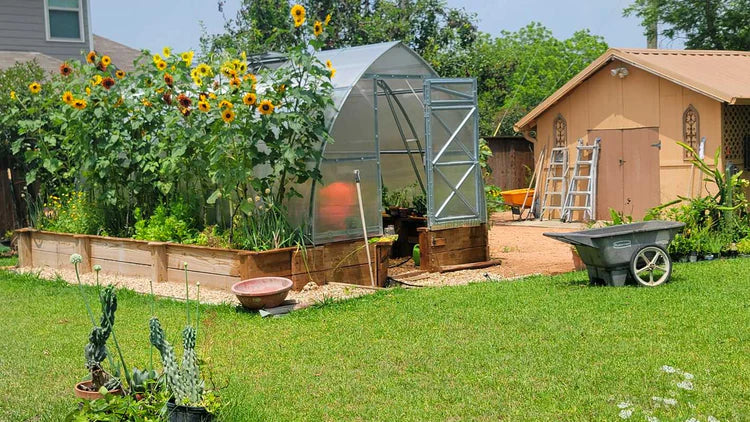
Greenhouses have long been a staple for gardeners who seek to extend their growing seasons, protect plants from harsh weather conditions, and cultivate a variety of crops in a controlled environment. Whether you’re an experienced gardener or a novice looking to elevate your outdoor space, understanding the full potential of a greenhouse is essential to achieving success in gardening. In this comprehensive guide, we’ll explore everything you need to know about greenhouses—why they’re so valuable, how to choose the right one, how to maintain it, and how to use it effectively to maximize your garden’s potential.
1. What Is a Greenhouse and Why Should You Have One?
At its core, a greenhouse is a structure designed to create a controlled environment for plants. By trapping heat from the sun, greenhouses allow you to grow plants in a more stable climate, protecting them from extremes of temperature, frost, and strong winds. The main benefit of a greenhouse is that it provides an optimal microclimate for plants, regardless of the outdoor weather conditions.
Greenhouses serve many purposes, making them an invaluable asset for any gardener. Whether you are looking to grow delicate tropical plants that wouldn’t survive the local climate, extend your growing season for vegetables, or simply want to enjoy fresh herbs year-round, a greenhouse can support a variety of gardening needs. With their ability to trap sunlight, they enable faster growth and help reduce the stress that outdoor plants face due to temperature fluctuations and pests.
Additionally, for those who enjoy gardening in cooler climates, a greenhouse is particularly beneficial as it allows you to cultivate plants in winter, thereby expanding your growing season into the colder months. With the right setup, your greenhouse can offer the perfect space for year-round gardening.
2. Types of Greenhouses: Which One Is Right for You?
Before you decide to invest in a greenhouse, it’s important to consider the various types available, as each type comes with its own benefits, depending on your space, climate, and gardening needs. There are three primary types of greenhouses: freestanding, attached, and mini greenhouses.
Freestanding Greenhouses
Freestanding greenhouses are standalone structures that can be placed anywhere in your garden. These greenhouses offer maximum flexibility and space, allowing you to grow a large variety of plants. They typically come in various sizes and can be customized to suit your needs. Freestanding greenhouses are ideal for larger gardens or those who want to create a dedicated growing space away from the rest of their garden.
Attached Greenhouses
Attached greenhouses are built onto an existing structure such as a house, garage, or shed. These greenhouses have the benefit of sharing a wall with a building, which provides additional warmth, especially in cooler months. They tend to be smaller than freestanding greenhouses and are ideal for those who have limited outdoor space or want to keep their greenhouse close to their home for easier access.
Mini Greenhouses
Mini greenhouses are compact and portable, making them ideal for small spaces or urban gardening. They can be placed on balconies, patios, or small backyards. Though limited in size, mini greenhouses are perfect for starting seedlings, growing herbs, or cultivating smaller plants. They are often made with lightweight materials, making them easy to move and store during the off-season.
3. Choosing the Right Materials
The material used for the construction of a greenhouse is another critical factor in determining its efficiency, durability, and performance. Greenhouses can be made from various materials, each offering different advantages depending on the climate and the specific needs of your plants.
Glass Greenhouses
Glass is a traditional material that is prized for its durability and aesthetic appeal. It allows for maximum light transmission, making it ideal for plants that require a lot of sunlight. Glass greenhouses are also highly resistant to UV radiation and provide excellent insulation. However, they can be expensive, and they may require more maintenance to keep them clean and free from damage.
Polycarbonate Greenhouses
Polycarbonate is a modern, energy-efficient material that offers excellent insulation. It’s available in both twin-wall and single-wall configurations, with twin-wall polycarbonate being more effective at retaining heat. This material is durable, lightweight, and provides good protection from UV rays. Polycarbonate greenhouses are typically more affordable than glass greenhouses and provide better insulation, making them an excellent choice for colder climates.
Polyethylene Greenhouses
Polyethylene, a type of plastic, is the most affordable greenhouse covering material. It’s available in single or double layers and is often used for hoop-style or tunnel greenhouses. While it’s not as durable as glass or polycarbonate, polyethylene provides decent light transmission and is lightweight. However, it may need to be replaced every few years due to wear and tear from exposure to the elements.
4. Essential Greenhouse Features
While the structure and materials of your greenhouse are important, there are also several essential features that can enhance its functionality and help you maintain a productive growing environment.
Ventilation
Good ventilation is critical in maintaining the proper temperature and humidity levels inside your greenhouse. Without adequate airflow, the greenhouse can become overheated, leading to plant stress and potentially harming your crops. Look for a greenhouse with adjustable roof vents, side vents, or louvered windows that allow air to circulate freely. Automated ventilation systems are available, which can open and close based on temperature fluctuations, reducing the need for manual adjustments.
Heating Systems
In regions with harsh winters or cold temperatures, a heating system may be necessary to maintain a suitable environment for your plants. There are a variety of options available, such as electric heaters, gas heaters, or even passive heating systems that use solar power. Be sure to choose a heating system that is energy-efficient and suited to the size of your greenhouse. Keep in mind that you may not need heating year-round—during milder months, natural sunlight may be sufficient to warm your greenhouse.
Irrigation Systems
An irrigation system is essential for keeping plants hydrated, especially in large greenhouses where manual watering can be time-consuming. Drip irrigation systems are ideal for greenhouses as they provide a slow and steady water supply directly to the roots of your plants, minimizing water waste. Automatic watering systems can be programmed to water at specific intervals, ensuring that your plants are consistently hydrated, even when you’re not around.
Shading and Temperature Control
In areas with intense sunlight, excessive heat can be a concern for your plants. Consider installing shading systems or using shade cloths to regulate the amount of sunlight entering the greenhouse. Shade cloths can help reduce the temperature inside, preventing your plants from overheating. Additionally, during hot weather, using fans to improve airflow can help keep the temperature at an optimal level.
5. How to Maximize Your Greenhouse’s Potential
Once your greenhouse is set up, it’s time to optimize its potential. Here are a few tips on how to make the most out of your greenhouse:
-
Plan Your Space Wisely: Make sure to organize your greenhouse in a way that allows for optimal airflow and easy access to all areas. Use shelves, hanging baskets, and vertical planting systems to maximize space and grow more plants.
-
Rotate Crops: Just like in outdoor gardens, crop rotation is essential in a greenhouse to prevent soil depletion and reduce the risk of pests and diseases. Plan to rotate your plants each season to keep the soil healthy.
-
Start Seeds Early: A greenhouse is an excellent place to start seeds for the upcoming growing season. By starting seeds early, you can give your plants a head start and ensure that they’re ready for transplanting when the weather outside becomes favorable.
-
Monitor Temperature and Humidity: Keep a close eye on temperature and humidity levels in your greenhouse. Use a thermometer and hygrometer to track the conditions and make adjustments as necessary. This is especially important when growing more delicate plants, such as tropical species or seedlings.
6. Maintaining Your Greenhouse
Regular maintenance is key to keeping your greenhouse in top condition. Clean the glass or plastic covering periodically to ensure maximum light penetration and inspect for any damage, such as cracks or tears. Check ventilation and irrigation systems regularly, and replace any parts that show signs of wear. Be mindful of pests and diseases, as greenhouses can sometimes harbor unwanted guests due to their controlled environment. Ensure that you address any pest problems quickly using organic pest control methods.
Conclusion
A greenhouse is an invaluable addition to any gardener’s outdoor strategy, offering the perfect environment for growing plants regardless of the weather. By choosing the right type of greenhouse, materials, and features, you can create a space that promotes healthy plant growth year-round. Whether you’re growing vegetables, herbs, or exotic plants, understanding how to optimize and maintain your greenhouse will ensure that your gardening efforts are successful and sustainable. With the right care and attention, your greenhouse can become a thriving sanctuary for your plants, enhancing both the beauty and productivity of your outdoor space.
You May Also Like
How Shade Sails Transform Ou ...
26 August 2025
Everything You Need to Know ...
12 March 2025
Is Your Gardening & Out ...
04 February 2025
Popular Post
Recent Posts
- How to Ensure Your Pool Meets Local Safety Standards August 28, 2025
- How Shade Sails Transform Outdoor Living Spaces August 26, 2025
- Top Tips for Maintaining Beautiful and Durable Wooden Floors August 20, 2025
- Mastering Interior Design with Timeless Decorative Elements August 14, 2025
- Essential Maintenance Tips for Commercial Roof Longevity July 16, 2025
Categories
- Cleaning & Maintenance (5)
- Flooring (1)
- Gardening & Outdoor (6)
- Home Decor (5)
- Home Improvement (6)
- HVAC (5)
- Interior Design (1)
- Moving (5)
- Plumbing (5)
- Real Estate & Property (5)
- Roofing (6)
- Smart Home (5)
Archives
- August 2025 (4)
- July 2025 (1)
- April 2025 (13)
- March 2025 (10)
- February 2025 (5)
- January 2025 (7)
- December 2024 (2)
- November 2024 (5)
- October 2024 (4)
- September 2024 (3)
- January 2024 (1)






